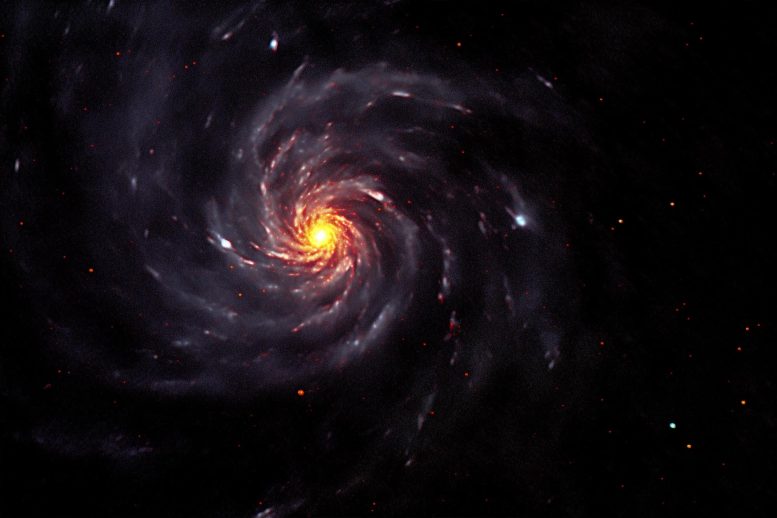
An unparalleled collaboration between citizen scientists, the SETI Institute, and Unistellar led to record-breaking observations of the supernova 2023ixf. The study engaged 123 observers and generated the longest continuous light curve of this supernova to date, emphasizing the significant contributions of citizen science in advancing astronomical research. (Artist’s concept.)
By combining the efforts of professional and citizen scientists, the study of cosmic cataclysms expands our understanding of the universe’s extraordinary phenomena.
In an unprecedented achievement, citizen scientists have set a new record for the SETI Institute and Unistellar, comprising the highest number of observers providing data on a single event. Amateur astronomers participating in the SETI Institute’s and Unistellar’s Cosmic Cataclysms program conducted a groundbreaking observation of supernova (SN) 2023ixf. The observations, which began just one hour after the supernova’s first known appearance, have generated the longest continuous light curve of this supernova gathered by citizen scientists that has been published to date. The data collection effort involved 123 observers and utilized Unistellar’s eVscope, with observations set to continue until the supernova is no longer visible, likely sometime in August. The accomplishment highlights the significant contributions made by citizen scientists in advancing astronomical research.
“It is really incredible what this citizen science network can do,” said Lauren Sgro, who led the study along with Tom Esposito. The two are part of a team of SETI Institute researchers guided by Franck Marchis, a senior astronomer at the SETI Institute and Chief Science Officer and co-founder at Unistellar. “This was the closest supernova of the last decade, and observers took full advantage of the special occasion. They jumped on target as soon as possible and kept observing, which allowed us to witness the full potential of this program.”
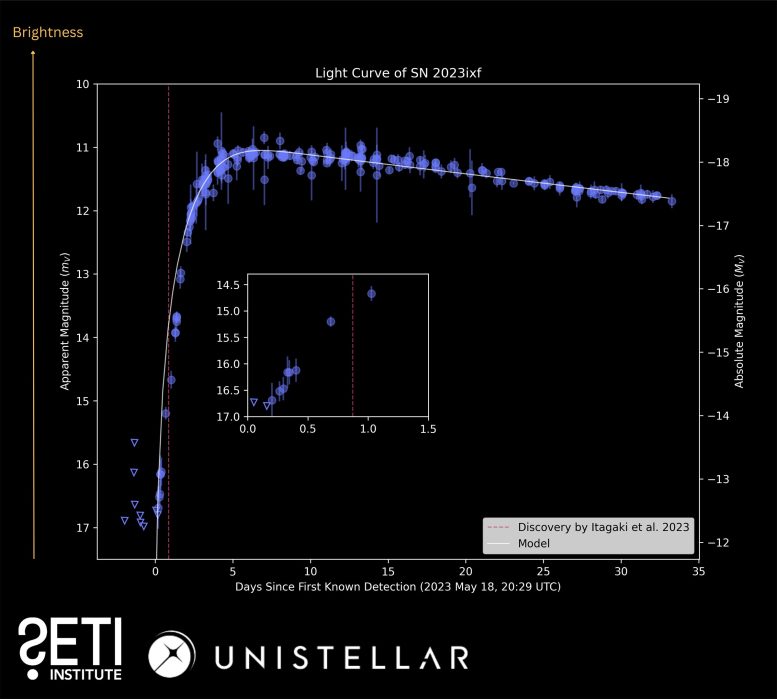
The light curve of supernova SN 2023ixf using data taken by SETI Institute / Unistellar citizen astronomers, which shows how the supernova’s brightness changed with time. Detections of the supernova are shown as filled circles, while observations that did not detect the supernova but revealed a limit to its brightness are shown as open triangles. The inset shows the first 1.5 days of observations taken by the citizen science network. The model fit is shown as a white line. Credit: Unistellar/SETI Institute
The research note, published in Research Notes of the American Astronomical Society, revealed that for 35 days, 252 observations from 115 telescopes captured the supernova’s escalating brightness, followed by its gradual decline. This extensive dataset provides valuable insights into the behavior of this supernova, thanks to the collaborative efforts of dedicated amateur astronomers.
The supernova (SN) 2023ixf occurred in the Pinwheel Galaxy, a spiral galaxy located approximately 21 million light-years from Earth. This explosive event was first discovered on May 19, 2023 by Japanese amateur astronomer Koichi Itagaki, although others’ observations show that it first appeared on May 18. Astronomers believe that the explosion likely led= to the formation of a neutron star, marking the final evolutionary stage of the star that went supernova.
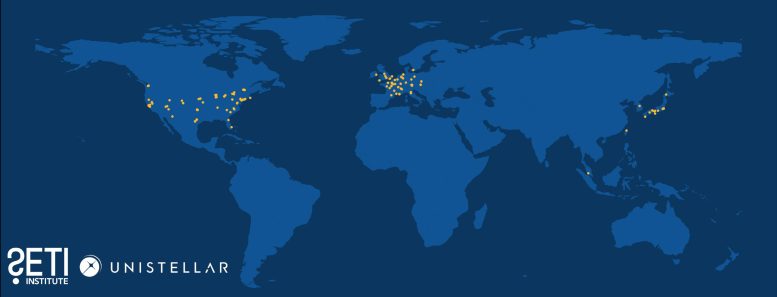
Locations of SETI Institute/Unistellar observers who contributed data on SN 2023ixf. Credit: Unistellar/SETI Institute
The citizen science campaign is part of the Cosmic Cataclysms science program, jointly undertaken by the SETI Institute and Unistellar. Funded by the Richard Lounsbery Foundation and the Gordon and Betty Moore Foundation, this program allows citizen astronomers to participate in studying cataclysmic events such as supernovae and gamma-ray bursts. By leveraging a newly developed alerts system, the program enables observers to receive real-time notifications when objects of interest are detected, ensuring swift initiation of observation campaigns. Analyzing the increase in brightness and subsequent fading of cataclysmic events, citizen astronomers assist researchers in unraveling crucial details about the progenitor object and the surrounding interstellar material.
Looking ahead, the Unistellar network of citizen astronomers will continue their endeavors by collaborating with other teams to investigate similar transient events when the Vera C. Rubin Observatory in Chile commences operations next year. By combining the efforts of professional and citizen scientists, the study of cosmic cataclysms reaches new heights, expanding our understanding of the universe’s extraordinary phenomena.
Reference: “Photometry of Type II Supernova SN 2023ixf with a Worldwide Citizen Science Network” by Lauren A. Sgro, Thomas M. Esposito, Guillaume Blaclard, Sebastian Gomez, Franck Marchis, Alexei V. Filippenko, Daniel O’Conner Peluso, Stephen S. Lawrence, Aad Verveen, Andreas Wagner, Anouchka Nardi, Barbara Wiart, Benjamin Mirwald, Bill Christensen, Bob Eramia, Bruce Parker, Bruno Guillet, Byungki Kim, Chelsey A. Logan, Christopher C. M. Kyba, Christopher Toulmin, Claudio G. Vantaggiato, Dana Adhis, Dave Gary, Dave Goodey, David Dickinson, David Koster, Davy Martin, Eliud Bonilla, Enner Chung, Eric Miny, Fabrice Mortecrette, Fadi Saibi, Francois O. Gagnon, Franois Simard, Gary Vacon, Georges Simard, Gerrit Dreise, Hiromi Funakoshi, Janet Vacon, James Yaniz, Jean-Charles Le Tarnec, Jean-Marie Laugier, Jennifer L. W. Siders, Jim Sweitzer, Jiri Dvoracek, John Archer, John Deitz, John K. Bradley, Keiichi Fukui, Kendra Sibbernsen, Kevin Borrot, Kevin Cross, Kevin Heider, Koichi Yamaguchi, Lea A. Hirsch, Liouba Leroux, Mario Billiani, Markus Lorber, Martin J. Smallen, Masao Shimizu, Masayoshi Nishimura, Matthew Ryno, Michael Cunningham, Michael Gagnon, Michael Primm, Michael Rushton, Michael Sibbernsen, Mike Mitchell, Neil Yoblonsky, Niniane Leroux, Olivier Clerget, Ozren Stojanović, Patrice Unique, Patrick Huth, Raymund John Ang, Regis Santoni, Robert Foster, Roberto Poggiali, Ruyi Xu, Ryuichi Kukita, Sanja Šćepanović, Sophie Saibi, Stefan Will, Stephan Latour, Stephen Haythornthwaite, Sylvain Cadieux, Thoralf Müller, Tze Yang Chung, Yoshiya Watanabe and Yvan Arnaud, July 2023, Research Notes of the AAS.
DOI: 10.3847/2515-5172/ace41f

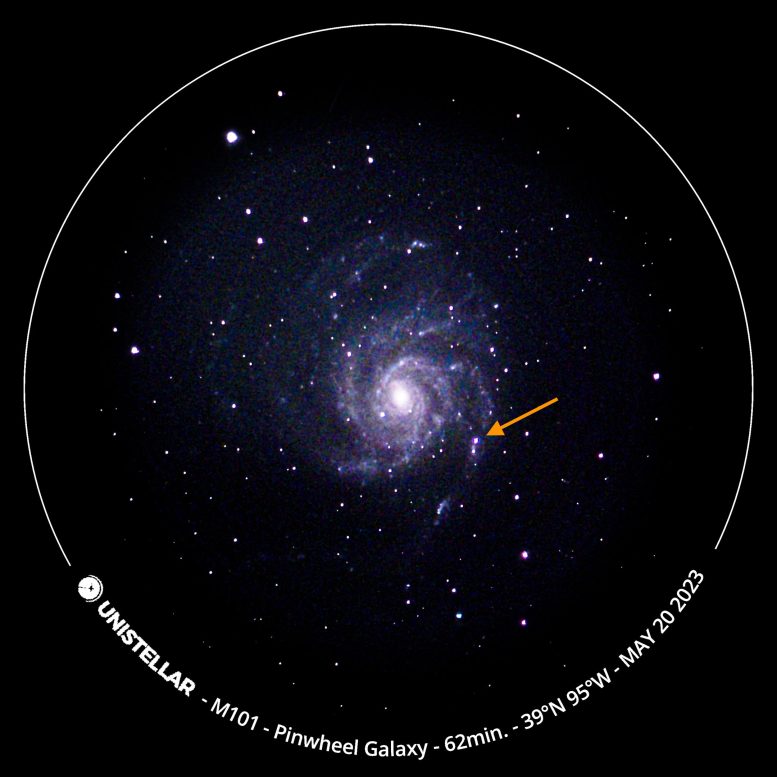
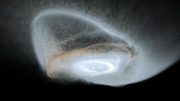
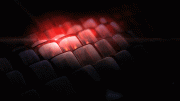

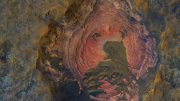

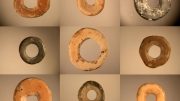
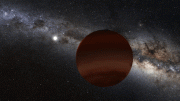

Be the first to comment on "Cosmic Cataclysms Unveiled: Citizen Scientists’ Record-Breaking Observation of Pinwheel Galaxy Supernova"